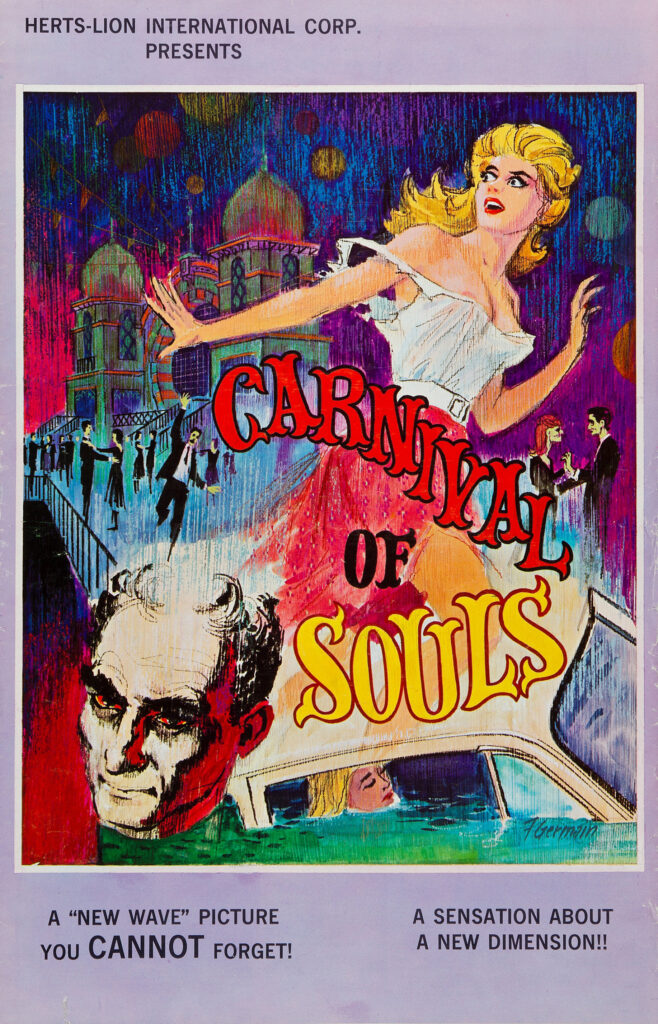Movie Review: “Carnival of Souls” (1962)
Title: Carnival of Souls (1962)
Director: Herk Harvey
Starring: Candace Hilligoss, Frances Feist, Sidney Berger
Genre: Horror, Mystery
“Carnival of Souls,” a 1962 cult classic, stands as a testament to the enduring power of atmospheric storytelling and minimalist horror. Directed by Herk Harvey and starring Candace Hilligoss, the film plunges into the eerie and unsettling realm of the supernatural with a subtle yet profound mastery.

By Illustration by F. Germain. Published by Herts-Lion International Corp. – Scan via Heritage Auctions. Cropped from original image., Public Domain, https://commons.wikimedia.org/w/index.php?curid=88371595
The film opens with a traumatic car accident, where we meet our protagonist, Mary Henry (Candace Hilligoss), a church organist and the sole survivor. The accident sets the stage for the film’s exploration of the ethereal and the macabre, as Mary finds herself drawn to a dilapidated carnival pavilion. This decaying structure becomes a central character in its own right, embodying the film’s themes of isolation and the surreal.
Following the accident, Mary attempts to leave her past behind, relocating to a new town for a fresh start. However, she’s haunted not just by the memories of the accident but also by a chilling, ghostly figure that seems to follow her wherever she goes. Her fascination with the abandoned carnival pavilion grows, as she is inexplicably drawn to its ghostly dance hall. As she tries to settle into her new life, playing the organ at a local church, her encounters with the supernatural intensify. These experiences culminate in her frequent, hypnotic visits to the pavilion, where the line between reality and illusion blurs. Mary’s isolation deepens as she grapples with these eerie occurrences, struggling to discern if they are hallucinations or a grim reality that is uniquely hers. This mysterious connection between Mary and the otherworldly elements of the carnival becomes the driving force of the narrative, enveloping her in a world that is both surreal and hauntingly familiar.
Hilligoss delivers a mesmerizing performance, capturing the essence of a woman caught between two worlds. Her haunting portrayal is a delicate balance of vulnerability and detachment, perfectly aligning with the film’s dreamlike atmosphere. Supporting performances by Frances Feist and Sidney Berger add layers to this eerie narrative, though it is Hilligoss who anchors the film’s ethereal quality.
The cinematography in “Carnival of Souls” is a character in itself. The use of stark black-and-white imagery, combined with unsettling camera angles, creates a sense of disorientation and otherworldliness. This visual style, alongside an effectively sparse soundtrack, amplifies the film’s haunting quality.
What sets “Carnival of Souls” apart is its subtle approach to horror. It relies less on jump scares and more on an overwhelming sense of dread and existential angst. The film’s pacing is deliberate, allowing the audience to sink deeper into its eerie ambiance. It’s a psychological journey through the protagonist’s psyche, exploring themes of alienation, identity, and the afterlife.
The climax of the film is both chilling and thought-provoking, leaving viewers with a lingering sense of unease. It’s a finale that invites multiple interpretations, a hallmark of the film’s enduring appeal.
In conclusion, “Carnival of Souls” is more than a horror movie; it’s a cinematic experience that delves into the depths of the human psyche. Its influence can be seen in many later works of horror and remains a must-watch for aficionados of the genre. It’s a hauntingly beautiful piece that resonates with the eerie and uncanny, making it a perfect discussion piece for our Blind Skeleton community, where the appreciation of the old, the mysterious, and the artistic converge.
